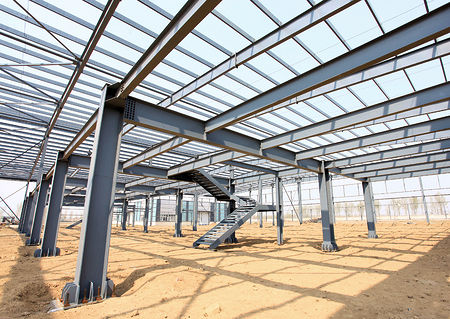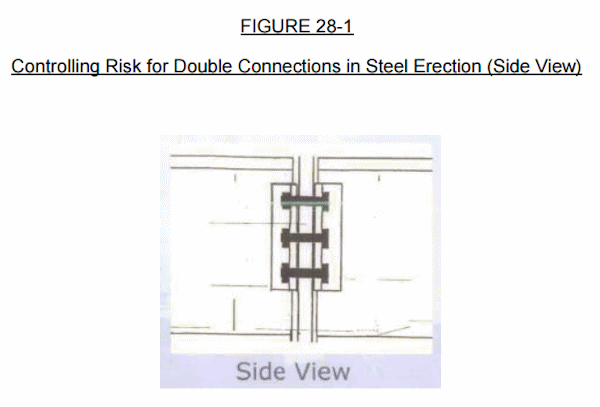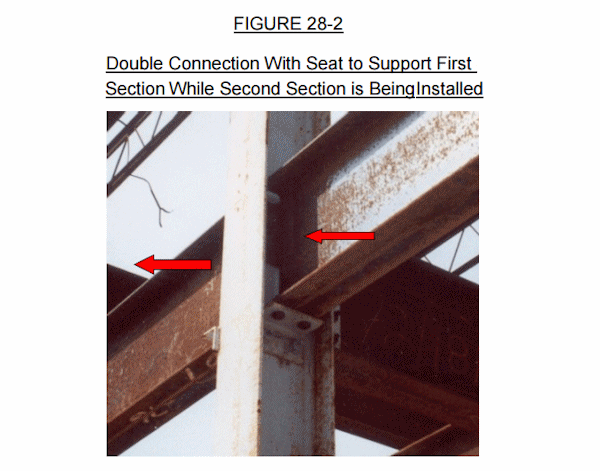28.B.17 Column anchorage.
- General requirements for erection stability.
- (1) All columns must be anchored by a minimum of four anchor rods or anchor bolts.
- (2) Each column anchor rod or anchor bolt assembly, including the column-to-base plate weld and the column foundation, must be designed to resist a minimum eccentric gravity load of 300 lbs (136.2 kg) located 18 in (45.7 cm) from the extreme outer face of the column in each direction at the top of the column shaft.
- (3) Columns must be set on level finished floors, pre-grouted leveling plates, leveling nuts, or shim packs. If shim packs are used, they must be used at the direction of a qualified person.
- (4) All columns must be evaluated by a CP to determine whether guying or bracing is needed; if guying or bracing is needed, it must be installed.
- Repair, replacement or field modification of anchor rods or anchor bolts.
- (1) Anchor rods or anchor bolts must not be repaired, replaced, or field-modified without the approval of the project structural engineer of record.
- (2) Prior to the erection of a column, the Controlling Contractor must provide written notification to the steel erector if there has been any repair, replacement, or modification of the anchor rods or anchor bolts of that column.
28.B.18 Beams and columns.
- During the final placing of solid web structural members, the load must not be released from the hoisting line until the members are secured with at least two bolts per connection (of the same size and strength as shown in the erection drawings) drawn up wrench-tight or the equivalent as specified by the project structural engineer of record, except as specified in Section 28.B.19.
- A CP must determine those pieces that require more than two bolts in each end before the piece is released from the crane. Column erection splices must be completely bolted prior to adding more than two floors.
28.B.19 Diagonal bracing. Solid web structural members used as diagonal bracing must be secured by at least one bolt per connection drawn up wrench-tight or the equivalent as specified by the project structural engineer of record.
28.B.20 Double connections.
- Double connections at columns and/or at beam webs over a column. When two structural members on opposite sides of a column web, or a beam web over a column, are connected sharing common connection holes, at least one bolt with its wrench-tight nut must remain connected to the first member unless a shop-attached or field-attached seat or equivalent connection device is supplied with the member to secure the first member and prevent the column from being displaced. > See Figures 28-1 and 28-2.
- If a seat or equivalent device is used, the seat (or device) must be designed to support the load during the double connection process. It must be adequately bolted or welded to both a supporting member and the first member before the nuts on the shared bolts are removed to make the double connection.
28.B.21 Column splices. Each column splice must be designed to resist a minimum eccentric gravity load of 300 lbs (136.2 kg) located 18 in (45.7 cm) from the extreme outer face of the column in each direction at the top of the column shaft.
28.B.22 Perimeter columns. Perimeter columns must not be erected unless:
- The perimeter columns extend a minimum of 48 in (121.9 cm) above the finished floor to permit installation of perimeter safety cables prior to erection of the next tier, except where constructability does not allow.
- The perimeter columns have holes or other devices in or attached to perimeter columns at 42-45 in (106.6-114.3 cm) above the finished floor and at the midpoint between the finished floor and the top cable to permit installation of perimeter safety cables except where constructability does not allow.
Knowledge Check Choose the best answer for the question.
28-5. Each column splice must be designed to resist _____.
You forgot to answer the question!



